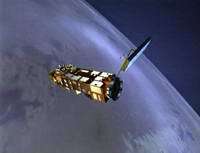Scientists meet to review Envisat results after two and a half years of operations

From 6 to 10 September in Salzburg, Austria, over 700 scientists from 50 countries worldwide will meet to review and discuss the early results of the European Space Agency’s Envisat satellite mission.
The main objective of the Symposium is to provide a forum for investigators to present results of ongoing research project activities and to review and assess the development of applications and services. Scientists and operational users of Envisat data working in the framework of international, ESA and national projects will present preliminary results from the Envisat mission and also the scientific benefits of the 13-year ERS missions.
The Symposium will address almost all fields of Earth science, including atmosphere, coastal studies, radar and interferometry, winds and waves, vegetation and agriculture, landslides, natural risks, gas mapping, ocean colour, oil spills and ice.
There are to be over 650 papers, selected by peer review. Presentations will include results from Envisat on the Prestige oil spill, fires in Portugal in 2003, the Elbe flooding in 2002, the evolution of the Antarctic ozone hole since the launch of Envisat, the Bam earthquake and pollution in Europe.
Numerous demonstrations are planned during the week in the ESA Exhibit area. An industrial consortium exhibit on GMES (Global Monitoring for Environment and Security) is also planned.
The official opening of the Symposium is scheduled for 6 September at 2.30 p.m. Mr Eduard Mainoni, Secretary of State at the Austrian Federal Ministry of Transport, Innovation and Technology, will give the welcoming address, followed by ESA Director General Jean-Jacques Dordain and ESA Director of Earth Observation Programmes José Achache.
Launched in March 2002, Envisat is the most powerful means ever created of monitoring the state of the planet and the impact of our activities on our world. It carries ten sophisticated optical and radar instruments to observe and monitor the Earth’s land, atmosphere, oceans and ice caps, maintaining continuity with the Agency’s ERS missions started in 1991.
Envisat data collectively provide a wealth of information on the workings of the Earth system, including insights into factors contributing to climate change. The satellite supports research activities and government programmes in the fields of global change, pollution and disaster monitoring, and commercial applications.
Source: ESA
















